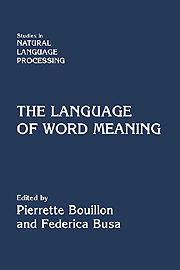Book contents
- Frontmatter
- Contents
- List of Contributors
- Preface
- Introduction: Word Meaning and Creativity
- Part I Linguistic Creativity and the Lexicon
- Part II The Syntax of Word Meaning
- 6 Introduction
- 7 Type Construction and the Logic of Concepts
- 8 Underspecification, Context Selection, and Generativity
- 9 Qualia and the Structuring of Verb Meaning
- 10 Sense Variation and Lexical Semantics: Generative Operations
- 11 Individuation by Partitive Constructions in Spanish
- 12 Event Coreference in Causal Discourses
- Part III Interfacing the Lexicon
- Part IV Building Resources
- Index
11 - Individuation by Partitive Constructions in Spanish
Published online by Cambridge University Press: 07 October 2011
- Frontmatter
- Contents
- List of Contributors
- Preface
- Introduction: Word Meaning and Creativity
- Part I Linguistic Creativity and the Lexicon
- Part II The Syntax of Word Meaning
- 6 Introduction
- 7 Type Construction and the Logic of Concepts
- 8 Underspecification, Context Selection, and Generativity
- 9 Qualia and the Structuring of Verb Meaning
- 10 Sense Variation and Lexical Semantics: Generative Operations
- 11 Individuation by Partitive Constructions in Spanish
- 12 Event Coreference in Causal Discourses
- Part III Interfacing the Lexicon
- Part IV Building Resources
- Index
Summary
Abstract
Because partitive constructions (“a grain of rice,” “a cup of coffee”) are one of the ways of individuating referents in many languages, there is a need to establish the mechanisms to obtain appropriate representations for such compounds by composing partitive nouns and noun phrases that denote a whole of reference. Furthermore, some partitives are nouns that show a polymorphic behavior. Namely, depending on the context, they may be interpreted either as object referents or as partitives (e.g., “cup,” container vs. cointainee interpretations). This work discusses these and other related issues and posits representations intended to account for such phenomena in Spanish. The main claim is that the semantics of partitives largely depends on constitutive information. More specifically, the semantics of portions seems to be grounded on a generalized construal of any entity as being made of some stuff.
Introduction
A semiotic need, which probably any existing or conceivable language has to satisfy, is the capability of referring to entities as discrete individual units. The mechanism by which languages extract individuals from a continuum of reference is usually called individuation (cf., e.g., Lyons, 1977).
Languages have different mechanisms to convey information about individuation. English uses deictic reference (“this”), pronouns (“him”), or a range of noun-headed constructions (“two trees,” “a branch,” “many cups of coffee,” “this team,” “a group of people,” “a head of cattle”).
- Type
- Chapter
- Information
- The Language of Word Meaning , pp. 192 - 215Publisher: Cambridge University PressPrint publication year: 2001
- 3
- Cited by



